Perfection would be a fatal flaw for evolution. Life’s hold on life depends on God losing his grip on life every once in a while.”
– Unknown
I’m not against the principle of Intelligent Design. Nor am I against that of Evolution. I don’t think either of them truly excludes the other. One could assume that the hand of some sort of creator got the whole thing going, with some careful, thoughtful design, and included evolution as part of the process. Pretty much it’s the premise behind the Hitchhiker’s Guide to the Galaxy four-part trilogy by Douglas Adams. It also doesn’t make a lick of difference in how I, or anyone I ever met, is going to lead their life. And, I see evidence of both processes in the kitchen. Some things are planned out in advance, other things evolve as the process proceeds. To rigidly adhere to either is to invite culinary disaster. And taking a tip from the anonymous quoter above, if you assume that a dish you’ve created has reached its ultimate form, and are unwilling to let something change, well, as far as I’m concerned, you may as well hang up your whisk.
Now, why the bit of exposition on the heated topic of Intelligent Design and Evolution? Well, simply that last night’s Casa S dinner involved several elements of both. Perhaps Guided Evolution would be a good term, though that probably violates the tenets of the formal process. One thing leads to another and all that – not surprisingly, I’m finding that menu by menu I take a bit from previous ones and incorporate them into the next ones.
First, there wasn’t really a theme to the dinner, at least not in the usual laser focused sort of topic that I pick out to be the guiding principle behind the menu. There was nothing that struck me as “oh, that’s the one”, and there were too many minor things to choose between. I picked three – there were two saints’ days (I know, I’m supposed to be a good Jewish boy from the Midwest, but the idea of saints’ days intrigues me) – one, the patron saint of shepherds, the other of beekeepers – so I figured lamb and honey were in the mix; and it was also the date on which the original patent for condensed milk was granted to one Mr. Borden, and right there you have dulce de leche in the making. Beyond that, it was just some things I was playing with.
I recently ran across my copy of The Nero Wolfe Cookbook by Rex Stout. If you don’t know Nero Wolfe, he was a fictional detective in a series of several dozen books written between the 1930s and 1950s. He was a committed gourmet, quite something of a cook (though he employed a highly skilled chef to prepare most of his meals), and orchid aficionado. The author, along with Chef Michael Romano, and several food writers, created and tested recipes for most of the dishes that get mentioned in the various novels. It’s a fascinating read, especially if you’re a bit of a mystery buff (the books, by the way, are well worth reading if you are), and I’ve tried out many of the recipes over time and always found them interesting. 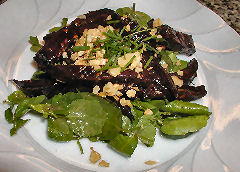 One is the Salad with Devil’s Rain Dressing, which appeared in a grand dinner prepared by Wolfe’s chef, Fritz Brenner, for a local dining society. I’ve tried it out before, and while there’s no question the original was excellent, I’ve made some steady modifications, and now just call it a Devil’s Rain Salad. The latest evolutionary step came after the beet terrine I prepared for last week’s menu. I thought that way of roasting the beets would fit in quite well with the salad, and they did! The original recipe calls for various lettuces, carrot curls, and celery bits; and raw garlic in the dressing. Perhaps the raw garlic along with the other spices is part of what gives the dressing it’s name, but since I still have quite a bit of that lovely roast garlic puree I made last week, I incorporated that into the dressing (vinaigrette of tarragon vinegar, red wine, hot English mustard, salt, cayenne, roasted garlic pureee, and olive oil). I also limited the salad components to watercress and a julienne of the roasted beets. The garnish is some chives (which originally were in the dressing), and a bit of chopped, toasted walnuts with salt and cayenne – shades of the pecan salt I also made last week.
One is the Salad with Devil’s Rain Dressing, which appeared in a grand dinner prepared by Wolfe’s chef, Fritz Brenner, for a local dining society. I’ve tried it out before, and while there’s no question the original was excellent, I’ve made some steady modifications, and now just call it a Devil’s Rain Salad. The latest evolutionary step came after the beet terrine I prepared for last week’s menu. I thought that way of roasting the beets would fit in quite well with the salad, and they did! The original recipe calls for various lettuces, carrot curls, and celery bits; and raw garlic in the dressing. Perhaps the raw garlic along with the other spices is part of what gives the dressing it’s name, but since I still have quite a bit of that lovely roast garlic puree I made last week, I incorporated that into the dressing (vinaigrette of tarragon vinegar, red wine, hot English mustard, salt, cayenne, roasted garlic pureee, and olive oil). I also limited the salad components to watercress and a julienne of the roasted beets. The garnish is some chives (which originally were in the dressing), and a bit of chopped, toasted walnuts with salt and cayenne – shades of the pecan salt I also made last week.
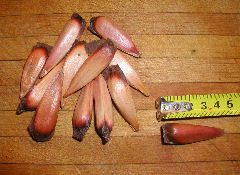 Okay, here’s where evolution, or perhaps lack of it, comes into play. The Monkey Puzzle Tree, Araucaria araucana, locally known as the Pehuén, is a conifer, a sort of pine, that appears left back in some sort of prehistoric age. Native to Chile and Argentina, it has a scaled trunk reminiscent of a scene out of Jurassic Park, and long, snaking, wicked looking branches. It makes for an amazingly bizarre looking bonsai. The tree, when polinated, produces cones that yield seeds. The seeds are in essence a type of pinenut, though unlike any pinenut you’re likely to encounter in your local supermarket. Here, however, I find them readily available in the Barrio Chino markets. I have to admit to curiosity as to what they get used for – I see people buying them, including restaurant people, but I’ve not, to my knowledge, encountered them on any menu yet.
Okay, here’s where evolution, or perhaps lack of it, comes into play. The Monkey Puzzle Tree, Araucaria araucana, locally known as the Pehuén, is a conifer, a sort of pine, that appears left back in some sort of prehistoric age. Native to Chile and Argentina, it has a scaled trunk reminiscent of a scene out of Jurassic Park, and long, snaking, wicked looking branches. It makes for an amazingly bizarre looking bonsai. The tree, when polinated, produces cones that yield seeds. The seeds are in essence a type of pinenut, though unlike any pinenut you’re likely to encounter in your local supermarket. Here, however, I find them readily available in the Barrio Chino markets. I have to admit to curiosity as to what they get used for – I see people buying them, including restaurant people, but I’ve not, to my knowledge, encountered them on any menu yet.
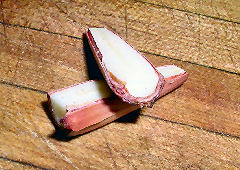
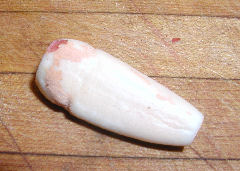
The seeds are covered in a husk, they are roughly four centimeters, or an inch and a half, in length. The husk is fairly thick and takes a bit of work to remove – more than I’d care to do on a regular basis I must admit. The seed inside looks like a giant pinenut. It’s texture is much the same, though a little moister or oilier – but I’m not sure that that just isn’t due to it being inside the husk; I’m used to pinenuts being peeled and at least somewhat air dried. The flavor seems slightly richer, but less nutty, than a standard pinenut, a touch like a chestnut. 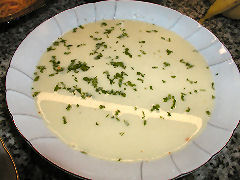 I’ve been thinking about trying a pesto made from them ever since Marc, from Asado Argentina sent me some thoughts about them a couple of weeks ago (and, interestingly, he just posted about them on his site as well). Instead, I decided to use them in a Pinenut Soup, which gave me the chance to offer a Monkey Puzzle Nut Soup. It was pretty straightforward – I toasted the peeled nuts with some salt, cayenne, and nutmeg. Then I pureed them into a chicken and vegetable stock base, and just before serving added cream and some tempered egg yolks (don’t bring back to a boil or the cream and yolks will separate and/or solidify). A little adjustment of the seasonings and a garnish of chopped parsley – it was delicious.
I’ve been thinking about trying a pesto made from them ever since Marc, from Asado Argentina sent me some thoughts about them a couple of weeks ago (and, interestingly, he just posted about them on his site as well). Instead, I decided to use them in a Pinenut Soup, which gave me the chance to offer a Monkey Puzzle Nut Soup. It was pretty straightforward – I toasted the peeled nuts with some salt, cayenne, and nutmeg. Then I pureed them into a chicken and vegetable stock base, and just before serving added cream and some tempered egg yolks (don’t bring back to a boil or the cream and yolks will separate and/or solidify). A little adjustment of the seasonings and a garnish of chopped parsley – it was delicious.
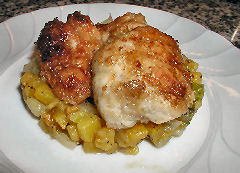 On my first trip to Argentina I found myself at a restaurant called Primafila, in the Buenos Aires Design center. One of the dishes I tried was an absolutely spectacular dish of sauteed sweetbreads accompanied by some caramelized batatas and fennel and the whole think dusted with cracked black peppercorns. I was so taken with the dish that I sent an e-mail missive back to one of my closest friend’s in New York extolling its virtues and proclaiming it the best sweetbreads I’d ever had. His response was “What the hell are you doing writing me about sweetbreads? You’re on vacation, just eat, relax, get some sun, enjoy!” He should know me well enough to know that a dish like that is part of why I travel! For those who don’t know, a sweetbread is a gland –
On my first trip to Argentina I found myself at a restaurant called Primafila, in the Buenos Aires Design center. One of the dishes I tried was an absolutely spectacular dish of sauteed sweetbreads accompanied by some caramelized batatas and fennel and the whole think dusted with cracked black peppercorns. I was so taken with the dish that I sent an e-mail missive back to one of my closest friend’s in New York extolling its virtues and proclaiming it the best sweetbreads I’d ever had. His response was “What the hell are you doing writing me about sweetbreads? You’re on vacation, just eat, relax, get some sun, enjoy!” He should know me well enough to know that a dish like that is part of why I travel! For those who don’t know, a sweetbread is a gland – 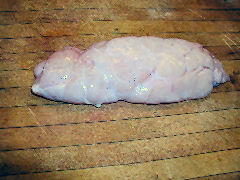 depending on what country you’re from it can either be the thymus gland or the pancreas (in the U.S. only the former, which is a shame, because the latter is the tastier one). I’ve played at recreating the dish several times, or at least coming up with my own version – including shortly after returning to New York, where I subjected the same friend and some others to the first attempt at it – pretty much everyone agreed it was about the best sweetbread dish they’d ever had. In its latest evolutionary step, I finely diced (¼”) both the batatas and fennel, and very finely julienned some fresh ginger. I soaked the batatas in water with some lemon slices for a couple of hours to soak up some moisture. I blanched the fennel. The batatas and ginger were sauteed in butter until the batatas were soft and starting to brown. I added the fennel at that point, along with a whole lot of cracked black peppercorns. A whole lot (1 large batata, four small fennel bulbs, and I used about 2 tablespoons of cracked peppercorns). Then I added about half a cup of honey and some salt and cooked it all until it just began to caramelize. This made the base of the dish. Meanwhile, the sweetbreads had been blanched, trimmed of most of its membrane, separated into pieces (roughly 1½”), soaked in salted milk for several hours, dusted in cornstarch, salt, and ground black pepper, and then sauteed in butter. Those went on top of the vegetable base. It was declared a hit, and I’m pretty happy with the current version, though I have no doubt there will be further iterations…
depending on what country you’re from it can either be the thymus gland or the pancreas (in the U.S. only the former, which is a shame, because the latter is the tastier one). I’ve played at recreating the dish several times, or at least coming up with my own version – including shortly after returning to New York, where I subjected the same friend and some others to the first attempt at it – pretty much everyone agreed it was about the best sweetbread dish they’d ever had. In its latest evolutionary step, I finely diced (¼”) both the batatas and fennel, and very finely julienned some fresh ginger. I soaked the batatas in water with some lemon slices for a couple of hours to soak up some moisture. I blanched the fennel. The batatas and ginger were sauteed in butter until the batatas were soft and starting to brown. I added the fennel at that point, along with a whole lot of cracked black peppercorns. A whole lot (1 large batata, four small fennel bulbs, and I used about 2 tablespoons of cracked peppercorns). Then I added about half a cup of honey and some salt and cooked it all until it just began to caramelize. This made the base of the dish. Meanwhile, the sweetbreads had been blanched, trimmed of most of its membrane, separated into pieces (roughly 1½”), soaked in salted milk for several hours, dusted in cornstarch, salt, and ground black pepper, and then sauteed in butter. Those went on top of the vegetable base. It was declared a hit, and I’m pretty happy with the current version, though I have no doubt there will be further iterations…
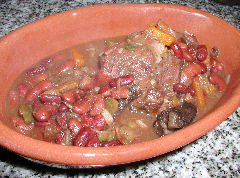 I make no claims to this dish, other than I’ve learned to prepare it well. It is the Spoon Lamb recipe from Antoine Bouterin, a famous French chef in New York. Any changes made to the dish were more out of necessity and practicality. Rather than leave the lamb in one large piece, I pre-portioned it to make it easier to serve at dinner time. There were no turnips to be found in the market, so I left them out. No navy beans to be found so I used other red beans. And, because I had a mixture of cracked black peppercorns and allspice from last week’s steaks, I used that rather than pepper and cloves. I slow cooked it on stove top rather than in the oven as I just didn’t have the space inside. This isn’t fancy food, but it’s somehow, despite in essence being a simple lamb and bean stew, very refined and elegant. Hopefully the Tasters Guild NY will leave the recipe on that link above, if it’s not there at some point in the future, feel free to ask me for it.
I make no claims to this dish, other than I’ve learned to prepare it well. It is the Spoon Lamb recipe from Antoine Bouterin, a famous French chef in New York. Any changes made to the dish were more out of necessity and practicality. Rather than leave the lamb in one large piece, I pre-portioned it to make it easier to serve at dinner time. There were no turnips to be found in the market, so I left them out. No navy beans to be found so I used other red beans. And, because I had a mixture of cracked black peppercorns and allspice from last week’s steaks, I used that rather than pepper and cloves. I slow cooked it on stove top rather than in the oven as I just didn’t have the space inside. This isn’t fancy food, but it’s somehow, despite in essence being a simple lamb and bean stew, very refined and elegant. Hopefully the Tasters Guild NY will leave the recipe on that link above, if it’s not there at some point in the future, feel free to ask me for it.
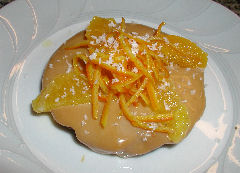 Yet one more step forward on my Dulce de Leche and Orange Tarts. They’ve popped up in several menus, and each time I wasn’t happy with some aspect of them. They’re still not where I want them, but moved a big step forward this week. I used the chocolate crust from last week’s chocolate tart, and went back to just the triple sec marinated orange supremes and some candied orange peel. I also changed the candying process for the peel – rather than slow cooking until completely caramelized, I wanted the vivid color of the fresh orange – so the finely slivered peel got itself blanched in plain water until soft, then shocked in ice water to set the color, and then cooked for just ten minutes in simple syrup (equal parts water and sugar) to infuse it with sweetness. While drying I tossed the peel with more sugar. I like the addition of the chocolate flavor to the tart, plus I sprinkled a little grated, unsweetened coconut on top. Definitely getting there…
Yet one more step forward on my Dulce de Leche and Orange Tarts. They’ve popped up in several menus, and each time I wasn’t happy with some aspect of them. They’re still not where I want them, but moved a big step forward this week. I used the chocolate crust from last week’s chocolate tart, and went back to just the triple sec marinated orange supremes and some candied orange peel. I also changed the candying process for the peel – rather than slow cooking until completely caramelized, I wanted the vivid color of the fresh orange – so the finely slivered peel got itself blanched in plain water until soft, then shocked in ice water to set the color, and then cooked for just ten minutes in simple syrup (equal parts water and sugar) to infuse it with sweetness. While drying I tossed the peel with more sugar. I like the addition of the chocolate flavor to the tart, plus I sprinkled a little grated, unsweetened coconut on top. Definitely getting there…
Wines of note for the evening:
Viñedos de Nieva “Pie Franco” Verdejo 2005 from the Rueda region in Spain – I love good Verdejo, or Verdelho, and this is a dry, rich, full bodied, honeyed, and very aromatic version that paired beautifully, as we suspected it might, with the sweetbread dish.
Rafael Cambra “Dos” 2003 from Valencia in Spain, a blend of 50:50 Cabernet Sauvignon and Cabernet Franc – bright berry fruit, good acidity, great balance, and just brimming with flavor. Light enough that it worked brilliantly with the appetizer dishes.
Bodega Franzini “Humanao” Reserva 2002 from the Salta region of Argentina – a Cabernet Sauvignon, I believe with a touch of Malbec in the blend – rich, ripe, great fruit, a nice dose of oak without overdoing it.
[…] I’ve mentioned this dish before – mollejas crocantes – crispy fried sweetbreads atop fennel and yams, and surrounded by a thick honey sauce. The dish seems to have changed slightly since I first tried it – the honey is less a sauce than just plain honey, and I don’t recall from my last time trying it the mix of seeds in the honey. I recall it being heavier on black pepper – now it’s fairly light on that and there are a range of other flavors from whole coriander and fennel seeds. The sweetbreads aren’t quite as crispy either. It’s still a great dish, but I’ve got to say, my version of it, while perhaps created from a misremembered version, is better. Just one man’s opinion. Hey, it opens up the menu for going back to trying other things on it. […]
[…] Each step has improved it in some way… and where we last left off, I’d made it into a tart with a chocolate shell. Last night’s evolutionary step took the dish, I think, forward in one way, but sidestepped […]
[…] the hosts had tried and really liked – the photo didn’t come out well, but you’ve seen it before. The biggest difference is that, having gone back to the restaurant where I got the idea, […]
[…] / Fennel / Sweet Potato / Honey – hearkened back to a dish I’ve done several times in different iterations. It was inspired, and more or less […]
[…] bit of an experiment. You may remember we’ve served up my take on a dish that I’d had at a local restaurant of honey and spice sweetbreads over sweet potatoes and […]
[…] cooked red deer steak with a quite good sauce made from araucaria seeds (I’ve used them once, a long time ago – Monkey Puzzle nuts), onions, and other good things, perhaps a touch heavy on rosemary, but […]
[…] see the different cultural variations on slow cooked lamb stews, from French, to Peruvian, to more French, and on to a third French version, Tex-Mex, Pakistani, Kashmiri… actually, it’s perhaps […]